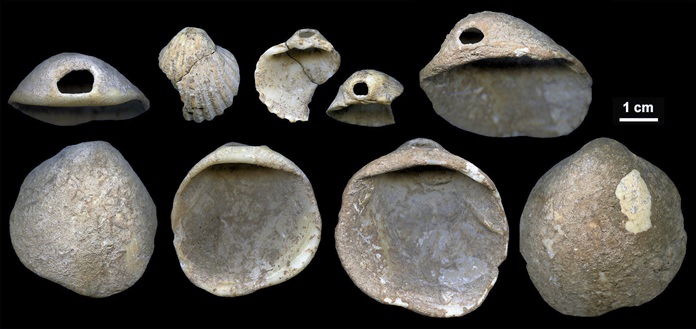
New York (AP) – From the murky depths of Spanish caves comes a surprising insight: Neanderthals created art.
 That’s been proposed before, but experts say two new studies finally give convincing evidence that our evolutionary cousins had the brainpower to make artistic works and use symbols.
That’s been proposed before, but experts say two new studies finally give convincing evidence that our evolutionary cousins had the brainpower to make artistic works and use symbols.
The key finding: New age estimates that show paintings on cave walls and decorated seashells in Spain were created long before our species entered Europe. So there’s no way Homo sapiens could have made them or influenced Neanderthals to merely copy their artwork.
Until now, most scientists thought all cave paintings were the work of our species. But the new work concludes that some previously known paintings – an array of lines, some disks and the outline of a hand – were rendered about 20,000 years before H. sapiens moved into Europe.
That’s a surprise that “constitutes a major breakthrough in the field of human evolution studies,” said Wil Roebroeks of Leiden University in the Netherlands, an expert on Neanderthals who didn’t participate in the new work.
Now, he said in an email, Neanderthal “ownership of some cave art is a fact.”
The second study provided evidence that Neanderthals used pigments and piercings to modify shells some 115,000 years ago, which is far earlier than similar artifacts are associated with H. sapiens anywhere. That shows Neanderthals “were quite capable of inventing the ornaments themselves,” said Paola Villa of the University of Colorado Museum in Boulder, who also didn’t participate in the new work.
Neanderthals lived in Europe and Asia before disappearing about 40,000 years ago, around the time H. sapiens moved into Europe from Africa.
The research, released Thursday by the journals Science and Science Advances, focused on determining the ages of previously known artifacts.
One team of European researchers concentrated on painted artwork in three caves in northern, southern and west-central Spain. They carefully removed tiny bits of rocky crust that had formed on the artwork surfaces and analyzed them in a lab. Results indicated artwork from all three were around 65,000 years old, much older than the arrival of H. sapiens in Europe, which occurred some 45,000 to 40,000 years ago.
The artwork is rudimentary, but a study author, Dirk Hoffmann of the Max Planck Institute for Evolutionary Anthropology in Leipzig, Germany, said it’s symbolic. One work is a collection of lines that look like a ladder, and others include red dots and disks on curtain-like rock formations. Another is a stenciled outline of a hand, made by spewing pigment over a hand held against the wall, Hoffmann said.
Making the hand stencil involves so many steps, including preparation of the pigment, that it’s clearly a deliberate creation, he and other authors wrote in the paper. What’s more, a number of hand stencils seem to have been placed with care rather than randomly, so they are certainly “meaningful symbols,” the authors wrote.
The other study sought to find the age of shells that had been colored and punctured in another cave, in southeast Spain. Previous studies had estimated an age of 45,000 to 50,000 years old, too young to rule out a link to H. sapiens.
For the new work, researchers analyzed rock that had formed above where the shells had been found.
Results indicated the shells were around 115,000 years old. That is some 20,000 to 40,000 years older than comparable artifacts in Africa or western Asia that are attributed to H. sapiens. The finding shows Neanderthals shared symbolic thinking with H. sapiens, and suggests the two species were “indistinguishable” in terms of overall mental ability, the researchers wrote.
Nobody knows what the shells symbolized. Maybe they indicated membership in a group like a clan, said Joao Zilhao of the Catalan Institution for Research and Advanced Studies in Barcelona, Spain, who did the study with Hoffmann and others.
Not all experts were convinced by the studies. Harold Dibble, an archaeologist at the University of Pennsylvania who studies Neanderthal behavior, wondered if the shell color and holes could have occurred naturally. And he said he’d like to see the dating in the cave art paper confirmed by another lab.
Warren Sharp of the Berkeley Geochronology Center in California, an expert on the dating technique used in both papers, said he found the results of both studies to be “very solid.”
They show “we are not the only ones capable of ‘modern’ behavior,” he wrote in an email.





